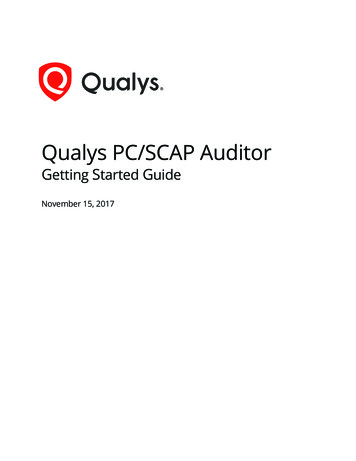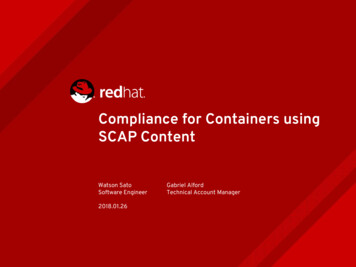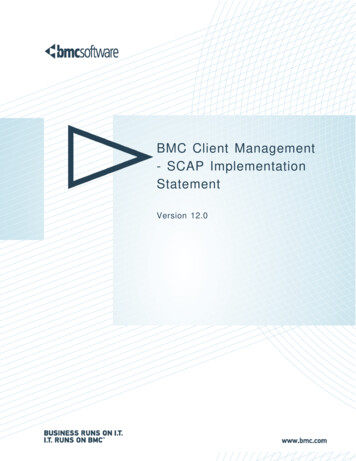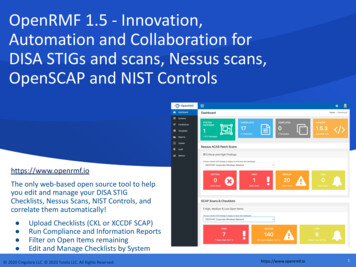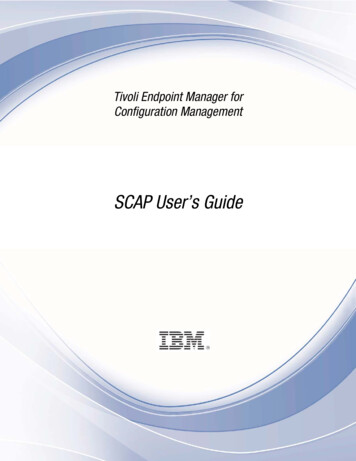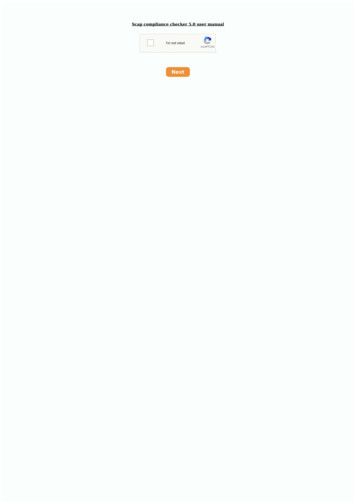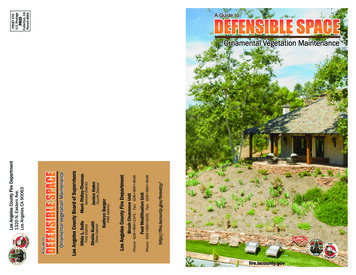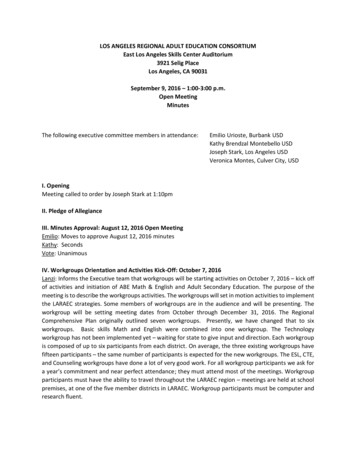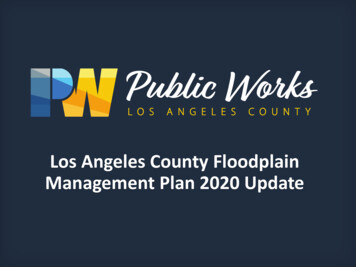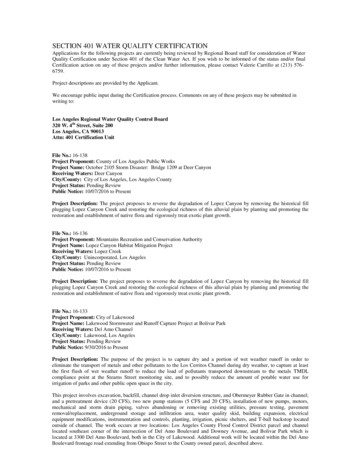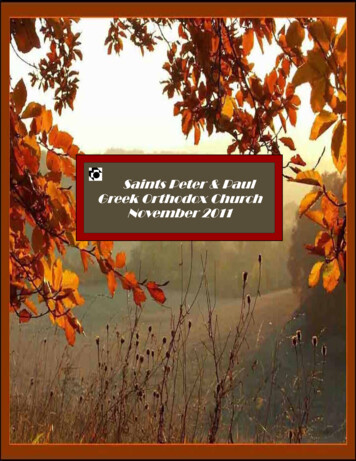
Transcription
COUNTY SANITATION DISTRICTSOF LOS ANGELES COUNTY1955 Workman Mill Road, Whinier, CA 90601-1400Mailing Address: PO. Box 4998, Whittier, CA 90607-4998Telephone: (562)699-741 1 , FAX: (562)699-5422www.lacsd.orgSTEPHEN R. MAGUINChief Engineer and General ManagerFebruary 23,2007File No.: 31B-380.10BMr. Marty KaySouth Coast Air Quality Management DistrictScience and Technology Advancement2 1865 E. Copley DriveDiamond Bar, CA 9 1765Dear Mr. Kay:Comments on Proposed Amended Rule 1110.2The Sanitation Districts of Los Angeles County (LACSD) appreciate the opportunity to commenton Proposed Amended Rule (PAR) 1110.2 for internal combustion engines (ICE) over 50 bhp. LACSDis responsible for wastewater collection and treatment for approximately 5.2 million people in LosAngeles County as well as solid waste management for a major portion of the County. Currently weoperate three 4,261 bhp lean hum (LB) landfill gas (LFG) fueled engine-generators at our Puente HillsLandfill (PHLF), a single 400 kW digester gas-fueled LB cogeneration ICE at the Valencia WaterReclamation Plant and five 1,564 bhp natural gas-fueled rich-bum (RB) engines driving secondaryinfluent pumps at our Joint Water Pollution Control Plant (JWPCP). The PHLF and JWPCP engines arecurrently operating with individual NOJO? CEMS.Reciprocating engines are an integral part of our operating philosophy given our continuous needto have reliable pumping and electrical power generation at all times. Engines are also an importantcomponent of effective management and utilization of landfill or digester gas, which we view as valuableresources of renewable energy. In fact, the State of California through SB 107 requires that investorowned utilities have 20 percent of its electricity from renewable sources by 2010. In addition, California,through its Climate Action Plan and AB32, has intended that renewable fuels he part of the solution forreducing the state's carbon footprint. The Climate Action Plan specifies that 20 percent of the energyfrom renewahles must come from bioenergy resources. Thus, LACSD believes that all reasonable meansshould be used by the permitting authorities to encourage energy production from biofuels. Thecomments presented below focus on specific concerns LACSD has with PAR 1110.2 and instances wherewe believe the proposed amendments are contrary to California mandates encouraging development ofrenewable energy.Natural Gas BACT RetrofitThe issue of greatest concern to LACSD is the requirement to retrofit existing biogas engines tomeet natural gas BACT standards. At issue here are the technical feasibility and economics of retrofittingengines to achieve compliance, and the precedent setting nature of these requirements.A stated goal of the proposed rule change is to "require facilities to retrofit or replace theirequipment to achieve BACT emission levels" (2007 AQMP Control Measure #2007MCS-01). In the case
Mr. Marty Kay-2-February 23,2007of LFG-fired engines, we do not know of any similar engines that are operating successfully at theproposed natural gas BACT standard. A 1,060 kW engine with a selective catalytic reduction (SCR) unitis currently operating at the Pacific Palms Hotel in the City of Industry, partially fueled by landfill gas(approximately 25 to 30 percent of the total heating value). This supplemental fuel has non-detectablelevels of siloxanes and is not representative of an engine operating on LFG. Assuming a system wouldwork, meeting the standards would require an extensive hiogas clean-up system to prevent poisoning ofSCRIoxidative catalysts on the exhaust stream. Adding to the cost of this system would be theengineering required to install this system in facilities that were not originally designed for thisequipment. Also, this blanket BACT retrofit requirement puts LB biogas engines in an unfair positionwhen compared to RB natural gas engines. A RB engine can comply with the BACT retrofit requirementby installing a modem airlfuel ratio controller and a three-way catalyst. While there is expense that willbe incurred, no additional fuel treatment is needed and the footprint shortage is not as severe. Westrongly recommend that SCAQMD Staff address these technological "achieved in practice" and retrofitcost issues as part of this rule making.While PAR 1110.2 is the first to apply draft Control Measure #2007MCS-01, it is likely thatSCAQMD will next target turbine facilities under Rule 1134, and boilers under Rule 1146. As a result ofthese tightening regulations, facilities will likely revert to flaring instead of risking the expense ofunproven technology. Such actions would be contrary to state mandates for renewable energy use.SCAQMD permitting policy has always recognized all of the factors that go into developing aneffective and economical solution to landfillldigester gas management and has always been technologyneutral in any mandates to bum these gases. SCAQMD staff in meetings and in the PAR 1110.2 staffreport contend that biogas facility ownerloperators have other energy options available, such as lowemission fuel cells, microturbines and gas clean-up to vehicle fuel. If these technologies wereeconomically viable, they would have been considered during project development, but the cost of thesedevices coupled with the low energy output per device, generally rule out their use. To date, mostapplications with this equipment have been demonstration in nature, with much of the capital for theprojects provided for through grants. Thus we consider many of the other low emission options to not hecomparable to engines; we object to the technology bias within PAR 1110.2.In addition to the technical issues surrounding natural gas BACT retrofits, there is the precedentsetting nature of SCAQMD rule development staff making policy that is counter to the decisions made bypermitting staff. This is certainly true in the case of permitting new equipment whereby the permittingstaff established what is reasonable BACT for that equipment. In many cases the affected facilities wererecently permitted and constructed. A basic tenet of any control strategy is that the equipment must serveout a useful life before being subject to new requirements. PAR 1110.2 conflicts with this long-heldtradition.In light of these technical, economic and policy issues, LACSD strongly recommends that PAR1110.2 extend the biogas exemption on emission limits or adopt language that would allow adequatereturns on investments and time for technology to advance. The latter concept currently exists in Rule1146.2 for small boilers. Our suggested language is as follows:"On or afferJanuary 1, 2012, no person shall operate in the District any landfill or digestergas-fired engine that is more than I5 years old, based on the original date of installation,which does not meet the emission limits specified in Table 111[BACT limits]."
Mr. Marty Kay-3-February 23,2007Biogas-Fired Engines and Natural Gas UsageStaff has added language to PAR 1110.2 eliminating the engine efficiency correction andrequiring new engines to meet the extremely stringent DG standards for all engines, if a facility burninglandfill or digester gas uses 10 percent or more natural gas on an annual basis. Energy facilities atlandfills are often planned to manage gas for the longest operational period possible during the life of thelandfill. Since LFG generation follows a bell curve in terms of volume and may have less than optimumgas BTU content on either side of the curve, natural gas is often used to supplement, or stabilize thecombustion process. A stable combustion process results in fewer emissions, and higher destructionefficiency for toxic air contaminants. The permitting staff generally reviews each project individually andmakes a case-by-case determination on the amount of natural gas needed to sustain a project. Financingand overall economics of the project are often dependent upon the facility being able to supplement withsome level of natural gas. Once again, actions that discourage biogas projects are counter to the state'smandate for utilities to use renewable fuels. Also, the rulemaking staff is making decisions counter to thepermitting staff who thoroughly evaluates the circumstances of each application. More importantly, thisconflict within an agency brings uncertainty to every permitting project.We strongly recommend that the PAR 1110.2 provide language that allows the usage of naturalgas for landfill and digester gas-fired engines up to 25 percent of the heat input, for stabilization purposes.Efficiency Correction Factor DeterminationPAR 1110.2 (d)(C)(i) provides for the determination of a biogas engine's energy consumption byusing ASME Performance Test Code (PTC) 17 at the average load. While LACSD appreciates theretention of the efficiency correction and recognizes the need for improving uniformity and compliancedetermination, we question whether ASME PTC-17 will be effective in practice. Even with a single loadtest, the PTC is very burdensome and complicated. The current language is also deficient in that only q,,net specific energy consumption based on net mechanical power output, is specified, which requires acalibrated dynamometer. For engine generators, qb, or energy consumption based on net electrical poweroutput, would be more appropriate. Section 7.3.2.1(d) of the PTC admits that "with few exceptions, theengine manufacturers' shops are the only facilities that are adequately equipped with calibrated testequipment; therefore it is recommended . . . tests be conducted at the works of the engine manufacturer."We suggest that the ASME PTC-17 requirement be modified to allow the use of alternate testmethods or the manufacturer-determined efficiency, subject to approval by the Executive Officer. It mayalso be better to specify the precise formula and the essential inputs for determining q, in Bthdhp-hr or qbin BtuIkW-hr without requiring strict adherence to PTC-17. For example, the proposed rule alreadymentions the use of the LHV of the fuel, but this can be further clarified as determined independently byASTM Method D-1826 (or equivalent).BACT vs. BARCT Emission Limit Averaging TimeLACSD is also concerned that engines currently subject to 1-hour BACT emission limits will befaced with 15-minute-based requirements. By reducing the emission limits from 36/250/2000 ppm forNOx/CO/VOC, respectively to 11/30/70 ppm over 15 minutes, PAR 1110.2 will not just match naturalgas BACT levels but exceed them, since current BACT limits are based on a 1-hour average. While the15-minute average works well with inspections via portable analyzers and we recognize the precedentwithin current Rules 1110.2, 1134 and 1146, it is inappropriate to go beyond BACT when the stated
Mr. Marty KayFebruary 23,2007New CEMS Compliance DatesFor existing engines that will need to install new CEMS or add CO CEMS, the proposedcompliance schedule is unrealistic. As currently written, engine operators must apply for new ormodified CEMS by 1/1/08 and have the changes completed and operational by 7/1/08. We request that atminimum, an additional six months be allowed to bring new monitors online. This is reasonableconsidering that a shortage of CEMS contractors or backlog with instrument manufacturers may occur,and one year is typically the minimum for large agencies to specify, procure and install capital equipment.With the pump engines at JWPCP, the five CEMS units are housed in a specially sized anddesigned building. To comply with PAR 1110.2, we must retrofit each unit to add CO CEMS. The lackof space available in the current CEMS cabinets means that either major reconfiguration is required orentirely new cabinets will be needed. Any modification to the current CEMS must also require carefulscheduling to maintain engine and CEMS availability. For these reasons, we request that the CEMSinstallation/operational deadline in PAR 1110.2 Table VII be revised to January 1, 2009. Likewise thecertification tests would then be completed by March 30, 2009. As to the CEMS application deadline of1/1/08, that date is reasonable provided the proposed amendments are adopted on 6/1/07.Startup ExemptionOn the provision for a 15-minute exemption from emission limits during engine startups in PAR1110.2 (h)(12), we request that the allowance be increased to at least 30 minutes. As you know, emissioncompliance for rich-bum engines cannot be achieved without sufficient engine and catalyst warm up.Additional flexibility is warranted since the required temperature and warm up period may vary withengine and catalyst design, operating load, as well as unit-specific exhaust system design.For LB engines there is no need of catalyst warm up, but for units such as our PHLF engines, theair-to-fuel ratio controllers perform best if the engines are not accelerated to normal load for 10 to 15minutes after a cold start. Abnormally high emissions may still occur during the delayed ramp-up that ispart of startup operation, and thus should be exempted.Further, there is a practical basis for a 30-minute startup exemption due to the use of block dataaverages. Block averages are much more straightforward to use, implement and analyze compared torolling averages. This approach is widely used in CEMS data acquisition systems, including the ones atLACSD. For engine startups that can occur at any time, even a short thermal stabilization period willoften impact two 15-minute averages. Thus we request for the startup exempt onto be extended to "nomore than 30 minutes or two consecutive 15-minute block averages".Reporting of Noncompliance Based on Portable Analyzers or Operating ParametersLACSD is concerned with the requirement in PAR 1110.2 (f)(D)(vii) for non-CEMS equippedengines to report excess emissions suggested by portable analyzers or operating parameters according toRule 430 procedures. Neither portable analyzers, control equipment parameters, nor engine operatingconditions can be expected to provide the same level of measurement quality as conventional Rule 218 or40 CFR 60 compliant CEMS. Doing so would create a host of difficult issues such as false breakdown ordeviation reports and questionable excess emission calculations based on imprecise correlations betweenoperating parameters and emissions.
Mr. Marty Kay-4-February 23,2007rulemaking objective is to bring existing BARCT engines to BACT. We are also not aware of any federalor state emission standards based on a 15-minute average.Practically speaking, reducing the averaging period from 1-hour to 15 minutes also unreasonablylimits operational flexibility for existing engines. In our experience with RB engines, excess emissionsare usually mitigated in the short term by engine speed changes or engine shutdown. Air-to-fuel ratiocontroller (AFRC) adjustments require instmmentation technicians separate from engine operations staff.To maintain pumping operations in these situations, a redundant unit typically must be ramped up orfreshly started. Thus, the process of discovering and reacting to an exceedance easily takes more than 15minutes.We request that a 1-hour average be considered in PAR 1110.2 emission limits for consistencywith both BACT guidelines and state distributed generation standards.CEMS Requirement for Engines with an Aggregated 1,000 bhpLACSD is also concerned about the increased and perhaps unnecessary cost that the proposedrule will have on industry. Currently for non-CEMS engines, compliance has consisted of a source testonce every three years. While this needs to be more frequent, the current proposal for aggregatingengines for the purpose of applying CEMS will be costly and unnecessary. For example in theinspections conducted by SCAQMD, the non-compliance rate improved from over 80% to about 50%between the first and second rounds. This demonstrates that compliance can improve with closerattention to engine operation, and that the CEMS proposal in PAR 1110.2 is perhaps overkill. Weeklymonitoring with a handheld monitor, as well as appropriate alarms, can dramatically increase compliancewithout the excessive cost of a CEMS. Our point is that under PAR 1110.2, engine testing will bechanged from the current timetable of once every three years to weekly monitoring, a vast improvementwhich will also dramatically improve compliance.LACSD does recognize SCAQMD's concem that under the current rules, large engines such as999 bhp units, are escaping frequent monitoring. However, we cannot see the logic of requiring CEMSon smaller engines, which would occur under SCAQMD's proposed aggregation of engines for thepurpose of applying CEMS. As a compromise, LACSD suggest that the aggregation language beeliminated, and the CEMS threshold be decreased to 750 bhp. In this way, it will be ensured that largerengines with the greater potential for emissions apply the more expensive monitoring option, but smallerengines will be captured under the weekly handheld monitoring provisions.Carbon Monoxide (CO) CEMS for Lean Burn EnginesThe additional CEMS requirements in PAR 1110.2 would apply to both LB as well as RBengines. However, the compliance statistics compiled by SCAQMD do not provide any basis for COanalyzers on lean-bum engines. Specifically, while 28% of the RB engines tested through surpriseinspections were out of compliance, none of the LB engines tested failed on CO. We request that the COcontinuous monitor requirement for LB engines be deleted from the proposed rule.
Mr. Marty Kay-6-February 23,2007As an option, LACSD supports the approach in the CARE RACT/BARCT Determination forStationary Spark-Ignited Internal Combustion Engines. In Chapter IV, Section K (pg. N-17) of thatdocument, the guideline reads "NOx emission readings [with a portable NOx analyzer] in excess of thelimits shall not be considered a violation, so long as the problem is corrected and a follow-up inspectionis conducted within 15 days of the initial inspection." Besides recognizing the lower accuracy of portableanalyzers, this language essentially gives a grace period for self-detected exceedance. Even if the graceperiod were tightened from 15 days to perhaps 1 day, it would incentivize the lmmedlate resolution ormitigation of excess emissions for engine operators desiring to avoid reporting. For this alternative, thefollowing language can be added to the end of Section (f)(D)(vii):' 2 n y potential noncompliance indicated by portable analyzers or operating parameters maybe exempted from Rule 430 reporting requirements so long as the engine operatorimmediately corrects the noncompliance and a follow-up inspection is conducted within 24hours of the initial test. AN these instances should be logged and the records made availablefor inspection."Summary and ConclusionsSCAQMD has added natural gas BACT retrofit provisions to biogas engine requirements whichwill encourage operators to choose flaring over energy recovery projects. This is contrary to California'spolicies with respect to use of renewable energy and biofuels to reduce greenhouse gas emissions.Because existing engines were permitted and installed with predetermined economics and BACTfeasibility, they should he allowed to operate for a useful life of 15 years and for a proper return oninvestment to owners. Similarly, the feasibility, life and economics of a resource recovery project oftendepend on natural gas augmentation. Current precedent established by SCAQMD permitting staff is toaccept 25% bv volume of natural gas blending for biogas equipment.With the efficiency correction for emission limits, we appreciate the reference to ASME PTC-17,but request for alternate approved methods or that the manufacturer-determined efficiency to be allowed.On the emissions averaging period, it is inappropriate for a BARCT rule to exceed BACT limits.Please consider a 1-hour average for any future amendments to the emission limits in the rule.The original purpose of PAR 1110.2 was to provide adequate monitoring to ensure a greater levelof compliance. This objective could he achieved without aggregating engines for the purpose of applyingCEMS, hut focusing on only the largest engines ( 750 hp), and allowing the remainder to perform weeklymonitoring with handheld monitors. Likewise, the SCAQMD compliance statistics show no basis forrequiring CO CEMS for existing LB engines at all. In addition, the compliance schedule for new CEMSis too short. We request for at least 6 additional months for installing new CEMS on existing facilities.The startup exemption is an important provision for day-to-day engine operations. However, werequest for this to be extended to 30 minutes or 2 consecutive 15-minute blocks in order to account forunit specific differences in design and operation.Finally, we object to Rule 430 reporting of excess emissions that are only suggested by operatingparameters or portable analyzers. We suggest a 24-hour mace period in which reporting is not required ifthe problem can be corrected and documented.
Mr. Marty Kay-7-February 23,2007We again thank you for the opportunity to comment on PAR 1110.2. Please contact theundersigned at (562) 699-741 1 ext. 21 13, should you have any questions regarding these comments.Very truly yours,Stephen R. MaguinGregory M. AdamsAssistant Departmental EngineerAir Quality Engineering SectionTechnical Services Departmentcc:Elaine ChangMohsen NazemiPhil FriessGrace Chan
OF LOS ANGELES COUNTY 1955 Workman Mill Road, Whinier, CA 90601-1400 Mailing Address: PO. Box 4998, Whittier, CA 90607-4998 Telephone: (562) 699-741 1, FAX: (562) 699-5422 www.lacsd.org STEPHEN R. MAGUIN Chief Engineer and General Manager February 23,2007 File No.: 31B-380.10B Mr. Marty Kay South Coast Air Quality Management District
